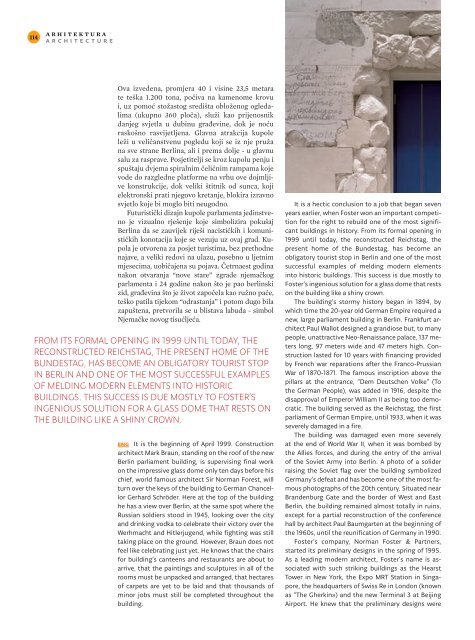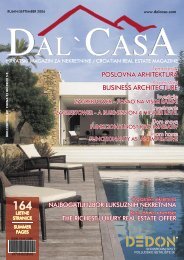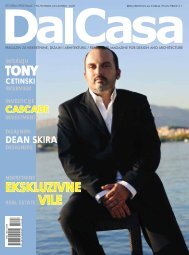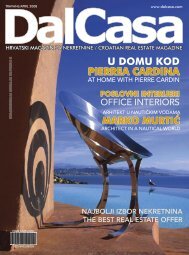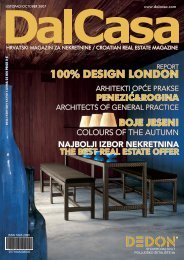Golf Park Dubrovnik - DalCasa
Golf Park Dubrovnik - DalCasa
Golf Park Dubrovnik - DalCasa
- No tags were found...
You also want an ePaper? Increase the reach of your titles
YUMPU automatically turns print PDFs into web optimized ePapers that Google loves.
114a r h i t e k t u r aa r c h i t e c t u r eOva izvedena, promjera 40 i visine 23,5 metarate teška 1.200 tona, počiva na kamenome krovui, uz pomoć stožastog središta obloženog ogledalima(ukupno 360 ploča), služi kao prijenosnikdanjeg svjetla u dubinu građevine, dok je noćuraskošno rasvijetljena. Glavna atrakcija kupoleleži u veličanstvenu pogledu koji se iz nje pružana sve strane Berlina, ali i prema dolje - u glavnusalu za rasprave. Posjetitelji se kroz kupolu penju ispuštaju dvjema spiralnim čeličnim rampama kojevode do razgledne platforme na vrhu ove dojmljivekonstrukcije, dok veliki štitnik od sunca, kojielektronski prati njegovo kretanje, blokira izravnosvjetlo koje bi moglo biti neugodno.Futuristički dizajn kupole parlamenta jedinstvenoje vizualno rješenje koje simbolizira pokušajBerlina da se zauvijek riješi nacističkih i komunističkihkonotacija koje se vezuju uz ovaj grad. Kupolaje otvorena za posjet turistima, bez prethodnenajave, a veliki redovi na ulazu, posebno u ljetnimmjesecima, uobičajena su pojava. Četrnaest godinanakon otvaranja “nove stare” zgrade njemačkogparlamenta i 24 godine nakon što je pao berlinskizid, građevina što je život započela kao ružno pače,teško patila tijekom “odrastanja” i potom dugo bilazapuštena, pretvorila se u blistava labuda - simbolNjemačke novog tisućljeća.From its formal opening in 1999 until today, thereconstructed Reichstag, the present home of theBundestag, has become an obligatory tourist stopin Berlin and one of the most successful examplesof melding modern elements into historicbuildings. This success is due mostly to Foster’singenious solution for a glass dome that rests onthe building like a shiny crown.eng It is the beginning of April 1999. Constructionarchitect Mark Braun, standing on the roof of the newBerlin parliament building, is supervising final workon the impressive glass dome only ten days before hischief, world famous architect Sir Norman Forest, willturn over the keys of the building to German ChancellorGerhard Schröder. Here at the top of the buildinghe has a view over Berlin, at the same spot where theRussian soldiers stood in 1945, looking over the cityand drinking vodka to celebrate their victory over theWerhmacht and Hitlerjugend, while fighting was stilltaking place on the ground. However, Braun does notfeel like celebrating just yet. He knows that the chairsfor building’s canteens and restaurants are about toarrive, that the paintings and sculptures in all of therooms must be unpacked and arranged, that hectaresof carpets are yet to be laid and that thousands ofminor jobs must still be completed throughout thebuilding.It is a hectic conclusion to a job that began sevenyears earlier, when Foster won an important competitionfor the right to rebuild one of the most significantbuildings in history. From its formal opening in1999 until today, the reconstructed Reichstag, thepresent home of the Bundestag, has become anobligatory tourist stop in Berlin and one of the mostsuccessful examples of melding modern elementsinto historic buildings. This success is due mostly toFoster’s ingenious solution for a glass dome that restson the building like a shiny crown.The building’s stormy history began in 1894, bywhich time the 20-year old German Empire required anew, large parliament building in Berlin. Frankfurt architectPaul Wallot designed a grandiose but, to manypeople, unattractive Neo-Renaissance palace, 137 meterslong, 97 meters wide and 47 meters high. Constructionlasted for 10 years with financing providedby French war reparations after the Franco-PrussianWar of 1870-1871. The famous inscription above thepillars at the entrance, “Dem Deutschen Volke” (Tothe German People), was added in 1916, despite thedisapproval of Emperor William II as being too democratic.The building served as the Reichstag, the firstparliament of German Empire, until 1933, when it wasseverely damaged in a fire.The building was damaged even more severelyat the end of World War II, when it was bombed bythe Allies forces, and during the entry of the arrivalof the Soviet Army into Berlin. A photo of a soliderraising the Soviet flag over the building symbolizedGermany’s defeat and has become one of the most famousphotographs of the 20th century. Situated nearBrandenburg Gate and the border of West and EastBerlin, the building remained almost totally in ruins,except for a partial reconstruction of the conferencehall by architect Paul Baumgarten at the beginning ofthe 1960s, until the reunification of Germany in 1990.Foster’s company, Norman Foster & Partners,started its preliminary designs in the spring of 1995.As a leading modern architect, Foster’s name is associatedwith such striking buildings as the HearstTower in New York, the Expo MRT Station in Singapore,the headquarters of Swiss Re in London (knownas “The Gherkin») and the new Terminal 3 at BeijingAirport. He knew that the preliminary designs were


